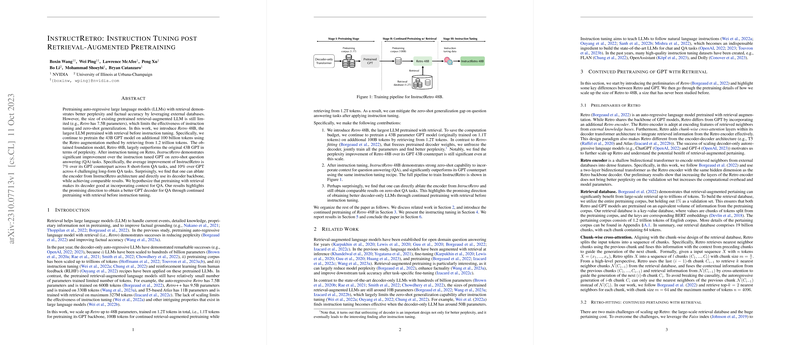Essay on "InstructRetro: Instruction Tuning post Retrieval-Augmented Pretraining"
The paper, "InstructRetro: Instruction Tuning post Retrieval-Augmented Pretraining," delineates an innovative approach to enhancing LLMs through a methodical application of retrieval-augmented pretraining followed by instruction tuning. This research introduces Retro 48B, a LLM distinguished by its significant increase in parameter size compared to its predecessors, thereby setting new benchmarks for performance in LLM pretraining and downstream task execution.
Overview of Methodology
The research leverages retrieval-augmented pretraining, a method which incorporates external databases to improve LLM precision and factual accuracy. Retro 48B represents a significant scale-up from previous generations like Retro 7.5B, demonstrating the authors' ability to efficiently scale the model while maintaining computational feasibility. This was achieved by initially pretraining a foundational 43B GPT model and subsequently enhancing it using the Retro augmentation method across an expansive corpus of 1.2 trillion tokens, with only a 2.58% increase in GPU hours compared to its unmodified counterpart. This efficiency in scaling highlights the model's potential and cost-effectiveness in achieving superior performance.
Instruction Tuning and Evaluation
Instruction tuning further refines the model's capacity to generalize across tasks without task-specific training data. InstructRetro, an outcome of this process, has shown notable improvements in zero-shot task handling. It excels in short-form QA, reading comprehension, long-form QA, and summarization tasks, showing an average improvement of 7%, 10%, and 16% across various task types when compared to a similarly sized GPT model. These figures underscore the model's enhanced ability to adapt to diverse task demands post instruction tuning.
Architectural Insights
One of the intriguing findings in this paper is the ability to ablate the encoder from the InstructRetro architecture. Remarkably, the decoder-only configuration (InstructRetro 43B) achieved results comparable to the complete original architecture (InstructRetro 48B). This suggests that the fundamental benefits from retrieval-augmented pretraining are well-preserved in the decoder, simplifying the architectural complexity without sacrificing performance.
Practical Implications and Future Directions
The practical implications of this research are substantial. Applications requiring rapid adaptation to new or uncommon tasks could benefit significantly from the model's zero-shot capability. Additionally, the findings suggest a promising directive for future research: refining the integration and instruction-tuning processes of LLMs with minimal reliance on fully retained architectures. Further research should explore retrieval-augmented instruction tuning with high-quality corpus-specific retrieval data to maximize the potential benefits of retrieval augmentation fully.
Conclusion
The "InstructRetro" paper provides a detailed and technical advancement in the arena of LLMs by demonstrating how retrieval-augmented pretraining, combined with instruction tuning, can produce models with superior performance and enhanced task adaptation capabilities. The paper not only broadens the potential applications of LLMs but also informs future research pathways for refining and optimizing LLM architectures.
